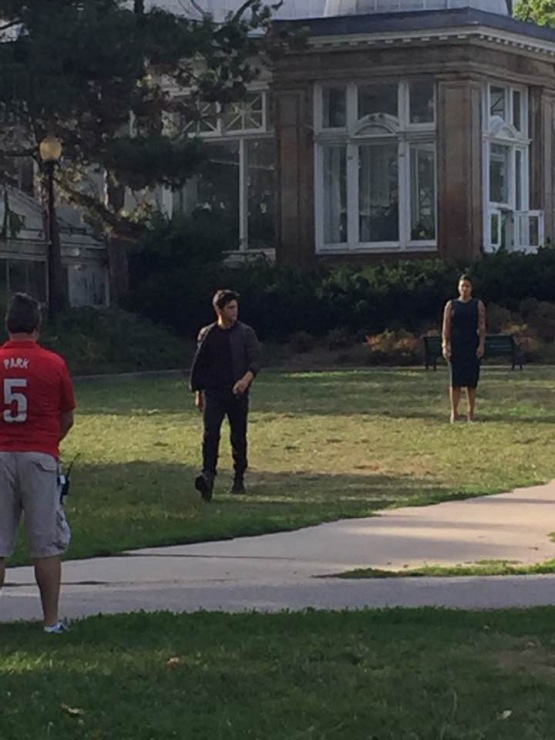Walking away from an argument
6 Guidelines For Walking Away From An Argument: Modern Therapy
Modern Therapy
Anger, Career, Lifestyle, Relationships, Stress
Modern Therapy
Anger, Career, Lifestyle, Relationships, Stress
It is common when fighting with someone you love to say things you later regret. This stems from our worst fears being brought out, whether it’s a fear being abandoned, betrayed, or unseen. When we fight with those we love, we often want to be heard and work through deep issues. Unfortunately, in the midst of fighting, resolutions don’t always come so easily. If you notice that you are becoming triggered, you should remove yourself from the situation. One of the best things you can do to prevent the fight from continuing is to allow one or both of you to take a short break.
This works when there is a prior agreement and strategies in place. Here are some guidelines:
1) Create an agreement
It is best to have a predetermined agreement that if one of you walks away from the fight, that it is temporary and you will return. It will not help the fight if one of you feels that the other is bailing from the situation. You don’t want to fear that if someone walks away, that it is the end of the relationship. Agree in advanced that either of you have the right to pause and come back when you are both calmer and clear headed.
2) Have a safe word
During a time when you are not fighting, establish an agreed upon word that can interrupt or prevent a blowout. Keep it simple and make sure it works for both of you. It can be something serious, such as ‘time out’ or it can be a silly word that could potentially lighten the mood. By having an agreed upon word, you are acknowledging the importance of stopping. When one of you says the word, the argument should come to a complete stop until you both agree that you are in a position to continue talking. Having a word will keep you from having to use an explanation when needing a break.
Having a word will keep you from having to use an explanation when needing a break.
3) Bring it to now
Sometimes when we become triggered, we make the fight about other things besides what is actually going on in the moment. You may be thinking about past times that you felt a similar way and want to bring up old things that have hurt you. You may be thinking about things that your partner has done to you or even things someone else has done. This can cause the fight to escalate and go to a place that is much deeper than the present issue. If you find yourself doing this, it may be time to acknowledge it and take a few minutes to calm yourself down and bring your mind back to the present situation.
4) Turn the conversation inward
If you find that you have trouble stopping yourself from talking, there is a probably a momentum going, which can be difficult to slow down. If this happens, try to voice inner thoughts that don’t match what you are saying. For example, instead of thinking about what your partner did or didn’t do, think about what you are currently contributing to the fight. This can help to interrupt any negative momentum enough that you should be able to walk away for a short break.
This can help to interrupt any negative momentum enough that you should be able to walk away for a short break.
5) Try to declare your love before walking out
This can be the most difficult part of walking away from a fight. When you are upset or angry at someone, the last thing you usually want to do is to tell them you love them. This is a game changer because it shows your significant other that you have every intention of coming back and working towards fixing your relationship. It also brings the issues into perspective and helps you to think about the bigger picture. It can be as simple as saying, “I’m a mess right now, but I do love you” prior to walking away.
6) Prioritize soothing yourself
Regardless of what is going on with your partner, your level of anger or sadness is with yourself. This could be because something painful was brought up and your emotions are high. It is okay to be with your emotions and give yourself permission to calm down. Consciously try to deep breaths, drink water, or allow yourself to cry. Do what you need to do in order to calm yourself down. It will be nearly impossible to have a productive conversation if you are too worked up and not in control of your thoughts and feelings.
Do what you need to do in order to calm yourself down. It will be nearly impossible to have a productive conversation if you are too worked up and not in control of your thoughts and feelings.
Tagged: how to walk away from an argument, why you should walk away from an argument, what to do when you're in a fight
When to Walk Away From an Argument
Skye Gould/Business InsiderI love watching someone's ego get in the way of common sense during an argument. And by love, I mean I love to laugh hysterically at it.
Some people can get so self absorbed, they don't realize they're in way too deep in an argument that has no end in sight. So because someone would rather yell back and forth until they're blue in the face, they lose the opportunity to walk away with grace and class.
So because someone would rather yell back and forth until they're blue in the face, they lose the opportunity to walk away with grace and class.
We've all been in this situation ourselves or witnessed it happening.
But walking away is not giving up or giving in — it's about ending an argument on your terms. When you're disagreeing with someone and you see that you're in an unwinnable spot, the key is to walk away before you end up in a scenario where it's nothing but irrational views 24/7.
So how to know when to walk away and when to fight the good fight? Check out my top 3 Quick and Dirty Tips for how walking away from an argument:
1. Know your opponent
Okay, so maybe the person you're arguing with is not really an "opponent" in the fighting sense. However, sometimes you'll encounter people with viewpoints you consider so off base, that you start to shout expletives like an NFL coach disputing a referee.
Sadly, there is no yellow flag that you could toss into an argument from the sidelines. You need to do that yourself. To throw the metaphorical yellow flag, you have to look at the person across from you and figure out what type of person they really are. After you figure that out, you'll now know how deep you can go and when to walk away.
You need to do that yourself. To throw the metaphorical yellow flag, you have to look at the person across from you and figure out what type of person they really are. After you figure that out, you'll now know how deep you can go and when to walk away.
One way to understand your opponent in an argument is to listen to how fast they lose their temper. When you're arguing with a rather sane person, the argument is more of a discussion, or a healthy debate. But when you're arguing with an irrational lunatic, an argument can quickly become a fight, and you never want that happen. So knowing how quickly your opponent can get off balance is a good gauge as to when you should walk away.
If your opponent gets heated after your first rebuttal, be prepared to pack your bags soon. How soon? Well, that depends on the type of conversation. But in any argument, the key is to make your point and leave with your pride and reputation intact. If the other person is willing to get nasty early on, this is your cue to drop your sword, smile, and simply walk away.
2. Your comfort zone
In some professions, arguing is as much a part of the job as having to wear a suit and tie. But unless you're a lawyer or prizefighter, arguments aren't part of your work life. I'd guess that for the majority of us (myself included) arguing is a hassle, it's annoying, and highly unmannerly.
When you raise your voice, you lose control. Whether right or wrong, you're giving away a piece of your own power, your leverage, to hold your rising tone. We all do this though. We can't help it. But it's how you harness that energy that separates mature adults from hair-trigger teenagers.
As I said in Tip #1, some people lose their temper quicker than others, because that's all they know. They use their tone and body language to push people around, and don't care about hearing anyone else's story, regardless of how wrong they are.
I can't stand these people!
Personally it makes me uncomfortable to be around them, and I refuse to engage in an argument with this type of person. It's just outside my comfort level. This is why I try to avoid loud arguments at all costs.
Please understand that this does not make me a pushover. Being mannerly doesn't mean being a wimp — it's about being respectful of those around you and of yourself. So when I'm in a situation where I feel a nasty argument coming on, I ask myself "How deep am I willing to take this?" and "How much aggression am I comfortable with?"
Answers to these questons will help you determine your comfort zone. If you know that anything past that point may take you into an unsafe area, where you might say something you will regret later, you will see it coming and walk away.
You are not admitting defeat, you're simply keeping a promise to yourself that you won't fall into someone else's anger trap.
You can use the "drop the mic" technique to end an argument on your own terms. Flickr/Robert Bejil3. Drop the mic
As a fan of stand-up comedy, I love watching how comedians end their sets. The really good ones end with a killer joke that makes everyone stand up and beg for more. Maybe the comedian comes back out to say thanks and wave, but that's it. A good comedian ends with homerun, then "drops the mic" and it's curtains. That's how you make a statement — that's how you say, "It's a wrap!"
Comedians use their wit and quick thinking to shock their audience. That's a great skill to have in an argument. Of course, if you've ever tried stand-up comedy, you know it's not nearly as easy as they make it appear.
Of course, if you've ever tried stand-up comedy, you know it's not nearly as easy as they make it appear.
You can use the "drop the mic" technique to walk away with your head held high from any argument. Say you're in a heated discussion with someone and you can see it going to the dark side. Instead of engaging any further, simply make your point, make it intelligently, don't leave any questions on the table, drop the mic, and walk away. If your opponent yells at you to come back to finish the argument — well, who looks silly now? Not you.
By dropping the mic, you leave the stage in control; you have the last word. When you walk away, it's on your terms. Who can argue with that?
How to argue and counter tricks in an argument
Photo by Vasya Sinichkin, Kublog In business communication, situations often arise when, when discussing a problem, one has to defend one's opinion, that is, to argue. Disputes most often arise because partners pay attention to mutually exclusive aspects of one phenomenon, and each of them is right in its own way. Sometimes the dispute is led by partners, each of whom cares only about their own interests. In this case, it is not necessary to count on achieving the truth.
Sometimes the dispute is led by partners, each of whom cares only about their own interests. In this case, it is not necessary to count on achieving the truth.
The most noble kind of dispute is the one that is conducted to clarify and compare different points of view, to search for the truth. The interlocutors logically substantiate their position, treat the arguments of the opposite side with respect and attention. Such a dispute is called a discussion (from the Latin discussio - research, consideration, analysis). There are no winners in the discussion: in the process of searching for the truth, everyone wins.
If the purpose of the dispute is to defend, defend one's opinion and refute the opponent's opinion, such a dispute is called a controversy (ancient Greek polemikos - warlike, hostile). Victory in controversy can be achieved by persuading the opponent. But often they strive for it at any cost, literally forcing the enemy to admit they were wrong. In this case, tricks are used. Such an argument, calculated to win at any cost, is often called eristic.
Such an argument, calculated to win at any cost, is often called eristic.
Business controversy can combine both goals: an argument for the sake of truth and an argument to convince the opponent. She does not exclude the use of various techniques that make it easier to win the dispute. The advantage is on the side of the one who is not only more deeply and comprehensively familiar with the problem, but also knows how to use these techniques, and also counteracts the tricks and techniques of eristics, that is, who owns the culture of polemics.
Basic rules for arguing
- You can only discuss the issue in which both sides are well versed. It is useless to argue about too close and too far.
- Accurately adhere to the issue under discussion, do not go away from the subject of discussion. Argue around the main thing, do not exchange for particulars.
- Do not allow methods of psychological pressure: getting personal, accusing a partner of unworthy motives for arguing, etc.

- Take a certain position. Be principled, but not stubborn.
- Observe the ethics of conducting polemics: calmness, restraint, goodwill.
To make it easier to succeed in a dispute, experienced polemicists use certain tactics and apply special techniques.
Debate tactics
We can recommend the following tactic for arguing:
- Arguments are arranged in the following order: strong ones at the beginning of the argument, and the strongest one at the end of it. In a dispute for persuasion, a strong argument is the one that seems the most convincing to the partner, as it affects his feelings, his interests. In a dispute for the sake of truth, this is an irrefutable logical argument.
- Exposing the possible arguments of the opponent, anticipating the arguments. This allows you to disarm the enemy before the attack. This technique was used in a dispute with Metropolitan A.
 I. Vvedensky People's Commissar of Education, an atheist A.V. Lunacharsky: “My opponent in his speech will almost certainly speak very lofty words about what a wonderful thing immortality is ... But the stronger these assurances, the stronger the power of deception in them, which makes you rely and rely on the unreal, non-existent - on the ancient, but a fragile tale. Naturally, the debunking of the opponent's arguments must be very convincing, otherwise you can only harm yourself.
I. Vvedensky People's Commissar of Education, an atheist A.V. Lunacharsky: “My opponent in his speech will almost certainly speak very lofty words about what a wonderful thing immortality is ... But the stronger these assurances, the stronger the power of deception in them, which makes you rely and rely on the unreal, non-existent - on the ancient, but a fragile tale. Naturally, the debunking of the opponent's arguments must be very convincing, otherwise you can only harm yourself. - Postponing the answer to a tricky question, answering at the right moment.
- When speaking as an opponent, if it is difficult to object to an argument, they use “deflecting an objection” or “an answer from afar” - reasoning about what they heard in order to gather their thoughts and prepare for an objection. Sometimes, for this purpose, the partner is asked questions, as if to clarify the argument.
- In a dispute, an effective refutation of secondary arguments is useful for winning (perhaps the partner decides that there is nothing more to argue about, this will confuse him, and he will hasten to admit that he was wrong).

Polemical techniques
The debate uses the following methods.
1. Finding out the principled position of the opponent on the controversial issue. This facilitates the search for the necessary arguments to convince the opponent, and sometimes makes further polemics meaningless.
2. Use of psychological arguments:
- argument to a person: an appeal to the personal qualities or actions of the person whose idea or proposal is being discussed;
- argument to the public: an appeal to the feelings of the witnesses of the dispute in order to incline them to the side of the speaker;
- reference to authority: to the statement or action of a person who has influence.
Arguments to the individual and to the public can have a strong psychological impact. In the story of A.P. Chekhov “A Case from Judicial Practice” describes a curious situation when the use of these techniques led not only to strong, but also unexpected results: after the speech of the lawyer, not only the jury and the public, but also the defendant himself, who, to the astonishment of the defender, admitted his guilt, were moved.
3. Comparison of the opponent's statement with his actions. This technique exerts strong pressure and, according to S.I. Povarnina, is one of the types of "mouth clamping". Therefore, it is not appropriate in the dispute for the truth. So, for example, in the novel by I.L. Goncharov "Oblomov" describes the dispute between Ilya Oblomov and Andrei Stolz. Oblomov criticizes Petersburgers for an empty life, doing nothing. He asserts: “We must go our own way, work…” The dispute ends with Stolz’s question “And you?..”
4. Turning the opponent's arguments against himself - a technique called "return blow."
In the discussion mentioned above, A.V. Lunacharsky with A.I. Vvedensky, both speakers used various polemical devices, including this one. So, in response to the argument of A.I. Vvedensky: “Religion is a certain value, at least from the order of opiates, for how many tears it dried up, how many wounds it healed ...” A.V. Lunacharsky declared: "Yes, that's true, but we don't want to alleviate suffering, but to treat the disease. "
"
5. The use of humor, irony, sarcasm. So, for example, in the same discussion A.I. Vvedensky said: “I noticed that in the vast majority of cases the best anti-religious people create their own understanding of religion and then victoriously destroy it. Such a struggle with the windmills of one's imagination about the religion of Christ has long been described in the immortal work of Cervantes.
6. Taking the initiative from the opponent, attacking with questions.
Tricks in a dispute and ways to protect yourself from them
As noted above, victory in an argument can be achieved with the help of cunning, using tricks and forbidden tricks.
Certain tactics and the use of polemical techniques make it easier to win the dispute. But these same techniques turn into tricks when they are used to psychologically pressure a partner or to mislead him.
So, for example, the tactic of "refuting minor arguments" can become a "ignoring argument" ploy, pretending that there was no strong argument. Or they go even further - they declare the argument untenable. This trick is called "retraction of the argument." After listening to the opponent, they say to him: “Are you serious?” or “So what?” In such cases, without embarrassment, one must say decisively: "I do not consider this an objection in essence."
Or they go even further - they declare the argument untenable. This trick is called "retraction of the argument." After listening to the opponent, they say to him: “Are you serious?” or “So what?” In such cases, without embarrassment, one must say decisively: "I do not consider this an objection in essence."
A clarifying question to buy time for reflection can become an "over-elaboration" ploy, requiring an answer to a question that makes no sense. For example, after the statement: “In the army, mothers often lose their sons,” they ask: “What kind of mothers? Can you name them?" There is no point in trying to answer such questions. It's better to say, "It doesn't matter" or "You're asking for the impossible."
By refuting the speaker's argument, the opponent may exaggerate some side of his statement to such an extent that it becomes ridiculous. This trick is called "reduction to the absurd." You can neutralize it by saying: "Let's not exaggerate" or "We must not exaggerate. "
"
The trick "appeal to the public" turns into a trick if, instead of a specific reference, they say: "In the opinion of the majority ..." or "In the opinion of the people ...". You can answer: "If this is so, I have my own opinion."
The “reference to authority” technique can become a trick if they refer to a high-ranking person unknown to the opponent or, raising a finger up, say meaningfully: “There is an opinion ...”. In such cases, the recommended answer is: "I appreciate this opinion, but, unfortunately, it does not prove anything."
The most serious of the tricks that can significantly complicate the dispute for an inexperienced polemist are tricks that violate the rules of polemics:
- Leaving aside, imposing your subject of discussion. In this case, it is worth saying: “This is very interesting, but back to our question” or “We are not talking about that! Your question deserves a separate discussion.
- Discussing the personal qualities or actions of the opponent.
 There is no need to please a dishonorable polemist and start making excuses. It’s better to say: “Sorry, we’re not talking about me right now.”
There is no need to please a dishonorable polemist and start making excuses. It’s better to say: “Sorry, we’re not talking about me right now.” - Distortion of the meaning of the statement. This trick looks like this: the opponent's thesis is distorted, then it is easily refuted and they pretend that they won the argument. At one time, the Izvestia newspaper published material calling for a reconsideration of the attitude towards people who were captured during the war. The Krasnaya Zvezda newspaper entered the controversy. She began like this: “The Izvestia newspaper publishes materials whose purpose is to present the shame of captivity with valor and heroism.” Having noticed the falsification, it is necessary to establish the truth, and if the original statement is not recorded or there are no witnesses and it is impossible to do this, then switch to discussing the statement of the opposite side.
- Attributing to the opponent side motives for arguing (the "reading in the heart" trick).
 For example: "You just want to argue" or "You want to be smarter than everyone else." There is no need to get angry and make excuses in this case. It is better to say: "Let's leave our intentions aside, let's return to the question of ..."
For example: "You just want to argue" or "You want to be smarter than everyone else." There is no need to get angry and make excuses in this case. It is better to say: "Let's leave our intentions aside, let's return to the question of ..." - Discussion of private points that are not relevant to the solution of the main issue. This must be tactfully but decisively suppressed.
Psychological tricks are also used, based on knowledge of the weaknesses of human nature.
- "Stunned" - fast, with many complex terms, self-confident, non-rebuttal tone. So that it does not confuse, you need to understand that all this is a psychological attack. Don't fall for the trick, stay calm. After the “volley”, ask to repeat everything from the beginning and more slowly.
- “Greasing the argument”, or flattery, for example: “You, as a smart (or intelligent, etc.) person, must agree that ...” The neutralization of the trick is simple - after hearing this, modestly say “Thank you” after the “compliment”.

- A bet on false shame - it is expected that the interlocutor will accept the argument without objection, embarrassed to show his ignorance. They begin persuasion like this: “Don’t you know that ...”, “As you know ...”. It is easy not to succumb to the trick, answering: “Imagine, I don’t know this,” and thereby making it clear that the opponent must substantiate his statement. If in a dispute they use incomprehensible terms, refer to theories unfamiliar to you, it is recommended not to pretend that everything is clear, but to the annoyance of the opponent, say: "Explain ...".
- A reference to your age, education, position, for example: “As a person with two higher educations, I affirm that ...” or “As a person who is suitable for your fathers ...”, etc. The defense against such a trick is the answer: "I know and appreciate your experience (or education, or age, etc.), but this is not an argument."
- “Pocket Argument” is the shift from reasoning about the truth of a statement to emphasizing its benefit to the opponent in the hope that when the benefit is clearly visible, it is difficult to see the truth.
 For example, there is a meeting on whether the organization needs a new PBX. A supporter of signing the relevant documents hints to his opponents that such a decision will please the higher authorities. If for a person his personal benefit is more important than the interests of the case, he will not be able to resist the “pocket argument”. Otherwise, he will calmly answer: “This is not relevant to the case.”
For example, there is a meeting on whether the organization needs a new PBX. A supporter of signing the relevant documents hints to his opponents that such a decision will please the higher authorities. If for a person his personal benefit is more important than the interests of the case, he will not be able to resist the “pocket argument”. Otherwise, he will calmly answer: “This is not relevant to the case.”
Logical tricks are manifested mainly in the deliberate violation of the logical requirements for arguments:
- False foundation. The big premise of deductive reasoning is a plausible proposition that is true in some cases. The opponent presents it as an axiom, for example: "And since it is impossible to change human nature, then ..." or "As you know, the old horse does not spoil the furrow, therefore ...". Having grasped that a statement that is true in a particular situation is presented as true under all conditions, it should be noted: “Just because it is true in a given situation does not mean that it is true at all.
 ”
” - Foundation anticipation. This trick was often used by I.V. Stalin, for example: "There is no need to say that the superiority of the collective farms over the individual economy will become even more indisputable." If we do not notice these errors in the arguments, we will have to “swallow” the conclusion as well, and as a result, admit defeat in the dispute.
- The opponent gives correct arguments, which, however, are clearly not enough for the assertion he defends. This should be pointed out to him.
- "Circle in proof" - any thought is proved with the help of its own, only expressed in other words.
- When criticizing an opponent, they use his words and terms, but put a different meaning into them and thereby distort the original idea. It is not difficult to neutralize this trick: having noticed the use of your terms in a different sense, you need to clarify the original concepts.
- Individual facts are opposed to the general trend, for example: “But I know a case .
 ..” You can interrupt the argument with the words: “A separate fact still does not say anything.”
..” You can interrupt the argument with the words: “A separate fact still does not say anything.” - They put forward a thesis, but they don’t substantiate it with anything, but simply say: “What do you actually have against this?” If the opponent succumbs to this trick and begins to give various arguments “against”, they look for flaws in them, thereby moving the center of the dispute. In order not to succumb to this trick, you need to ask the opponent: “Why do you think so?”, thereby forcing the partner to substantiate his statement himself.
- "Shining generalizations" - what the opponent said about some side or particular manifestation of the phenomenon is transferred to the whole phenomenon as a whole, for example: "Are you against reforms?" or “So say that you are against raising the standard of living!”. Making excuses is not the best way out. Better come on! Say, for example, the following: “You are making too bold generalizations!”
- "Imposed consequence" - after listening to the arguments of the opponent, one's own conclusion is made, which does not follow at all from his reasoning.
 Defense against this trick: "I would not draw such a conclusion" or "It does not follow from my reasoning."
Defense against this trick: "I would not draw such a conclusion" or "It does not follow from my reasoning."
The flow of controversy involves answers to questions. This can be used for the following tricks:
- Requiring a “yes” or “no” answer where unambiguousness can lead to a misunderstanding of the essence of the problem. In response to this, one should say: "Here a definite answer is impossible."
- Ignoring a question or answering a question with a question, which allows the opponent to take the initiative. Neutralization of this trick: "Allow me, there was my question!".
- A negative assessment of the question itself, for example: “Everyone knows this!” or "That's not a question", etc. Neutralization of the trick: "I would like to hear your opinion."
To neutralize these and other tricks, you need to know them, be attentive, and also train your decisiveness and quickness of thinking.
How to debate and neutralize tricks
Business polemics can combine both goals: an argument for the sake of truth and an argument to convince the opponent. She does not exclude the use of various techniques that make it easier to win the dispute. The advantage is on the side of the one who is not only more deeply and comprehensively familiar with the problem, but also knows how to use these techniques, and also counteracts the tricks and techniques of eristics, that is, who owns the culture of polemics.
Author: Tatyana Pavlovna Avdulova, Candidate of Psychological Sciences, Associate Professor, Department of Developmental Psychology, Moscow State Pedagogical University.
In business communication, situations often arise when, when discussing a problem, you have to defend your opinion, that is, to argue. Disputes most often arise because partners pay attention to mutually exclusive aspects of one phenomenon, and each of them is right in its own way. Sometimes the dispute is led by partners, each of whom cares only about their own interests. In this case, it is not necessary to count on achieving the truth.
Sometimes the dispute is led by partners, each of whom cares only about their own interests. In this case, it is not necessary to count on achieving the truth.
The noblest type of dispute is one that is conducted to clarify and compare different points of view, to search for the truth. The interlocutors logically substantiate their position, treat the arguments of the opposite side with respect and attention. Such a dispute is called a discussion (from the Latin discussio - research, consideration, analysis). There are no winners in the discussion: in the process of searching for the truth, everyone wins.
If the purpose of the dispute is to defend, defend one's opinion and refute the opinion of the opponent, such a dispute is called a controversy (ancient Greek polemikos - militant, hostile). Victory in controversy can be achieved by persuading the opponent. But often they strive for it at any cost, literally forcing the enemy to admit they were wrong. In this case, tricks are used. Such an argument, calculated to win at any cost, is often called eristic.
Such an argument, calculated to win at any cost, is often called eristic.
Business polemics can combine both goals: arguing for the sake of truth and arguing to convince the opponent. She does not exclude the use of various techniques that make it easier to win the dispute. The advantage is on the side of the one who is not only more deeply and comprehensively familiar with the problem, but also knows how to use these techniques, and also counteracts the tricks and techniques of eristics, that is, who owns the culture of polemics.
- You can only discuss the issue in which both parties are well versed. It is useless to argue about too close and too far.
- Stick to the subject under discussion exactly, do not deviate from the subject of discussion. Argue around the main thing, do not exchange for particulars.
- Do not allow methods of psychological pressure: getting personal, accusing a partner of unworthy motives for arguing, etc.
- Take a certain position.
 Be principled, but not stubborn.
Be principled, but not stubborn. - Observe the ethics of polemics: calmness, restraint, goodwill.
To make it easier to succeed in a dispute, experienced debaters use certain tactics and special techniques.
We can recommend the following tactic for arguing:
- Arguments are arranged in the following order: the strong ones are at the beginning of the argument, and the strongest one is at the end of it. In a dispute for persuasion, a strong argument is the one that seems the most convincing to the partner, as it affects his feelings, his interests. In a dispute for the sake of truth, this is an irrefutable logical argument.
- Exposing the possible arguments of the opponent, anticipating the arguments. This allows you to disarm the enemy before the attack. This technique was used in a dispute with Metropolitan A.I. Vvedensky People's Commissar of Education, an atheist A.V. Lunacharsky: “My opponent in his speech will almost certainly speak very lofty words about what a wonderful thing immortality is .
 .. But the stronger these assurances, the stronger the power of deception in them, which makes you rely and rely on the unreal, non-existent - on the ancient, but a fragile tale. Naturally, the debunking of the opponent's arguments must be very convincing, otherwise you can only harm yourself.
.. But the stronger these assurances, the stronger the power of deception in them, which makes you rely and rely on the unreal, non-existent - on the ancient, but a fragile tale. Naturally, the debunking of the opponent's arguments must be very convincing, otherwise you can only harm yourself. - Postponing the answer to a tricky question, the answer at the right time.
- When speaking as an opponent, if it is difficult to object to an argument, they use "procrastination of the objection" or "reply from afar" - reasoning about what they heard in order to collect their thoughts and prepare for the objection. Sometimes, for this purpose, the partner is asked questions, as if to clarify the argument.
- In a dispute, an effective refutation of secondary arguments is useful for winning (perhaps the partner decides that there is nothing more to argue about, this will confuse him, and he will hasten to admit that he was wrong).
The following methods are used in the debate.
1. Finding out the principled position of the opponent on the controversial issue. This facilitates the search for the necessary arguments to convince the opponent, and sometimes makes further polemics meaningless.
2. Use of psychological arguments:
- argument to a person: an appeal to the personal qualities or actions of the person whose idea or proposal is being discussed;
- argument to the public: an appeal to the feelings of the witnesses of the dispute in order to incline them to the side of the speaker;
- reference to authority: to the statement or action of a person who has influence.
Arguments to the individual and the public can have a strong psychological impact. In the story of A.P. Chekhov “A Case from Judicial Practice” describes a curious situation when the use of these techniques led not only to strong, but also unexpected results: after the speech of the lawyer, not only the jury and the public, but also the defendant himself, who, to the astonishment of the defender, admitted his guilt, were moved.
3. Comparison of the opponent's statement with his actions. This technique exerts strong pressure and, according to S.I. Povarnina, is one of the types of "mouth clamping". Therefore, it is not appropriate in the dispute for the truth. So, for example, in the novel by I.L. Goncharov "Oblomov" describes the dispute between Ilya Oblomov and Andrei Stolz. Oblomov criticizes Petersburgers for an empty life, doing nothing. He asserts: “We have to go our own way, work…” The argument ends with Stolz's question “And you?
In the discussion mentioned above, A.V. Lunacharsky with A.I. Vvedensky, both speakers used various polemical devices, including this one. So, in response to the argument of A.I. Vvedensky: “Religion is a certain value, at least from the order of opiates, for how many tears it dried up, how many wounds it healed ...” A.V. Lunacharsky declared: "Yes, that's true, but we don't want to alleviate suffering, but to treat the disease."
5. Use of humor, irony, sarcasm. So, for example, in the same discussion A.I. Vvedensky said: “I noticed that in the vast majority of cases the best anti-religious people create their own understanding of religion and then victoriously destroy it. Such a struggle with the windmills of one's imagination about the religion of Christ has long been described in the immortal work of Cervantes.
So, for example, in the same discussion A.I. Vvedensky said: “I noticed that in the vast majority of cases the best anti-religious people create their own understanding of religion and then victoriously destroy it. Such a struggle with the windmills of one's imagination about the religion of Christ has long been described in the immortal work of Cervantes.
6. Taking the initiative from the opponent, attacking with questions.
As noted above, victory in an argument can be achieved with the help of cunning, using tricks and forbidden tricks.
Certain tactics and the use of polemical techniques make it easier to win an argument. But these same techniques turn into tricks when they are used to psychologically pressure a partner or to mislead him.
So, for example, the tactic of "refuting minor arguments" can become a "ignoring argument" ploy, pretending that there was no strong argument. Or they go even further - they declare the argument untenable. This trick is called "retraction of the argument." After listening to the opponent, they say to him: “Are you serious?” or “So what?” In such cases, without embarrassment, one must say decisively: "I do not consider this an objection in essence."
This trick is called "retraction of the argument." After listening to the opponent, they say to him: “Are you serious?” or “So what?” In such cases, without embarrassment, one must say decisively: "I do not consider this an objection in essence."
A clarifying question to buy time for reflection can become an "over-qualifying" ploy when asking for an answer to a question that makes no sense. For example, after the statement: “In the army, mothers often lose their sons,” they ask: “What kind of mothers? Can you name them?" There is no point in trying to answer such questions. It's better to say, "It doesn't matter" or "You're asking for the impossible."
In refuting the speaker's argument, the opponent may exaggerate some side of his statement to such an extent that it becomes absurd. This trick is called "reduction to the absurd." You can neutralize it by saying: "Let's not exaggerate" or "We must not exaggerate."
The “appeal to the public” technique turns into a trick if, instead of a specific reference, they say: “In the opinion of the majority . ..” or “In the opinion of the people ...”. You can answer: "If this is so, I have my own opinion."
..” or “In the opinion of the people ...”. You can answer: "If this is so, I have my own opinion."
The “reference to authority” technique can become a trick if they refer to a high-ranking person unknown to the opponent or, raising a finger up, say meaningfully: “There is an opinion ...”. In such cases, the recommended answer is: "I appreciate this opinion, but, unfortunately, it does not prove anything."
The most serious of the tricks that can significantly complicate the dispute for an inexperienced polemist are tricks that violate the rules of polemics: In this case, it is worth saying: “This is very interesting, but back to our question” or “We are not talking about that! Your question deserves a separate discussion.
 This trick looks like this: the opponent's thesis is distorted, then it is easily refuted and they pretend that they won the argument. At one time, the Izvestia newspaper published material calling for a reconsideration of the attitude towards people who were captured during the war. The Krasnaya Zvezda newspaper entered the controversy. She began like this: “The Izvestia newspaper publishes materials whose purpose is to present the shame of captivity with valor and heroism.” Having noticed the falsification, it is necessary to establish the truth, and if the original statement is not recorded or there are no witnesses and it is impossible to do this, then switch to discussing the statement of the opposite side.
This trick looks like this: the opponent's thesis is distorted, then it is easily refuted and they pretend that they won the argument. At one time, the Izvestia newspaper published material calling for a reconsideration of the attitude towards people who were captured during the war. The Krasnaya Zvezda newspaper entered the controversy. She began like this: “The Izvestia newspaper publishes materials whose purpose is to present the shame of captivity with valor and heroism.” Having noticed the falsification, it is necessary to establish the truth, and if the original statement is not recorded or there are no witnesses and it is impossible to do this, then switch to discussing the statement of the opposite side.  .."
.."
Psychological tricks are also used, based on knowledge of the weaknesses of human nature.
- "Stunned" - fast, with many complex terms, self-confident, non-rebuttal tone. So that it does not confuse, you need to understand that all this is a psychological attack. Don't fall for the trick, stay calm. After the “volley”, ask to repeat everything from the beginning and more slowly.
- “Greasing the argument”, or flattery, for example: “You, as a smart (or intelligent, etc.) person, must agree that ...” The neutralization of the trick is simple - after hearing this, modestly say “Thank you” after the “compliment”.
- A bet on false shame - it is expected that the interlocutor will accept the argument without objection, embarrassed to show his ignorance. They start persuasion like this: “Don’t you know that .
 ..”, “As you know ...” It’s not difficult to resist the trick by answering: “Imagine, I don’t know this” and thereby making it clear that the opponent must substantiate his statement. If in a dispute they use incomprehensible terms, refer to theories unfamiliar to you, it is recommended not to pretend that everything is clear, but to the opponent’s annoyance, say: “Explain ...”
..”, “As you know ...” It’s not difficult to resist the trick by answering: “Imagine, I don’t know this” and thereby making it clear that the opponent must substantiate his statement. If in a dispute they use incomprehensible terms, refer to theories unfamiliar to you, it is recommended not to pretend that everything is clear, but to the opponent’s annoyance, say: “Explain ...” - A reference to one's age, education, position, for example: “As a person with two higher educations, I affirm that ...” or “As a person who is suitable for your father ...”, etc. The defense against such a trick is the answer: "I know and appreciate your experience (or education, or age, etc.), but this is not an argument."
- "Pocket Argument" - the transition from reasoning about the truth of the statement to emphasizing its benefits for the opponent in the hope that when the benefits are clearly visible, it is difficult to discern the truth. For example, there is a meeting on whether the organization needs a new PBX.
 A supporter of signing the relevant documents hints to his opponents that such a decision will please the higher authorities. If for a person his personal benefit is more important than the interests of the case, he will not be able to resist the “pocket argument”. Otherwise, he will calmly answer: “This is not relevant to the case.”
A supporter of signing the relevant documents hints to his opponents that such a decision will please the higher authorities. If for a person his personal benefit is more important than the interests of the case, he will not be able to resist the “pocket argument”. Otherwise, he will calmly answer: “This is not relevant to the case.”
Logical tricks are manifested mainly in the deliberate violation of the logical requirements for arguments:
- False base. The grand premise of deductive reasoning is a plausible proposition that is true in some cases. The opponent presents it as an axiom, for example: "And since it is impossible to change human nature, then ..." or "As you know, the old horse does not spoil the furrow, therefore ...". Having grasped that a statement that is true in a particular situation is presented as true under all conditions, it should be noted: “Just because it is true in a given situation does not mean that it is true at all.
 ”
” - Anticipation of the foundation. This trick was often used by I.V. Stalin, for example: "There is no need to say that the superiority of the collective farms over the individual economy will become even more indisputable." If we do not notice these errors in the arguments, we will have to “swallow” the conclusion as well, and as a result, admit defeat in the dispute.
- The opponent gives correct arguments, which, however, are clearly not enough for the assertion he defends. This should be pointed out to him.
- "Circle in proof" - any thought is proved with the help of its own, only expressed in other words.
- When criticizing an opponent, they use his words and terms, but put a different meaning into them and thereby distort the original idea. It is not difficult to neutralize this trick: having noticed the use of your terms in a different sense, you need to clarify the original concepts.
- Separate facts oppose the general trend, for example: “But I know a case .
 ..” You can interrupt the reasoning with the words: “An individual fact still does not say anything.”
..” You can interrupt the reasoning with the words: “An individual fact still does not say anything.” - They put forward a thesis, but they do not substantiate it, they simply state: “What do you actually have against this?” If the opponent succumbs to this trick and begins to give various arguments “against”, they look for flaws in them, thereby moving the center of the dispute. In order not to succumb to this trick, you need to ask the opponent: “Why do you think so?”, thereby forcing the partner to substantiate his statement himself.
- "Shining generalizations" - what the opponent said about some side or particular manifestation of the phenomenon is transferred to the whole phenomenon as a whole, for example: "Are you against reforms?" or “Say that you are against raising the standard of living!” Making excuses is not the best way out. Better come on! Say, for example, the following: “You are making too bold generalizations!”
- "Imposed investigation" - after listening to the opponent's arguments, one's own conclusion is drawn, which does not follow at all from his reasoning.















